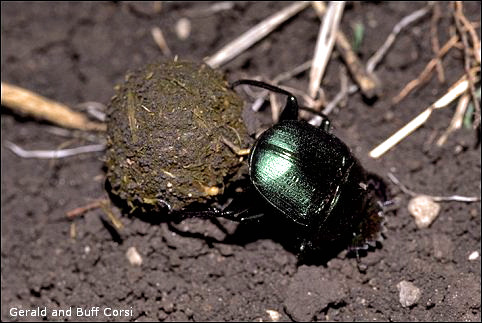
Perhaps you've come across a hard-working beetle, rolling something carefully across the desert floor. But what is it rolling? It couldn't possibly be dung—or could it???
One group of scarabs, the dung beetles, are some of our most efficient
recyclers. They actually make use of the droppings of other animals. If a pair of these
beetles find a cow pie, they will quickly gather dung into a nice, round ball—and
then roll it away to where they'll dig a hole, bury the dung, and the female lays
her eggs in it. Why would they do such a thing? Perhaps the decaying dung keeps the
eggs warm? Or maybe it discourages any predators from disturbing the developing young?
But no, these devoted parents are providing important sustenance for their children.
The young beetles actually EAT the dung, which provides them with the valuable
nutrients needed for growth! 
Aren't we lucky to have some friendly workers helping to keep our desert clean?
Listen to the Audio (mp3 format) as recorded by KTEP, Public Radio for the Southwest.
Contributor: Kodi R. Jeffery, formerly with the Centennial Museum, University of Texas at El Paso.
Desert Diary is a joint production of the Centennial Museum and KTEP National Public Radio at the University of Texas at El Paso.

A dung beetle and its prize. Photograph by Gerald and Buff Corsi, © California Academy of Sciences, 1999.
Borror, D. J., and R. E. White. 1970. A Field Guide to Insects, America North of Mexico. Houghton Mifflin Co., Boston, 404 pp.